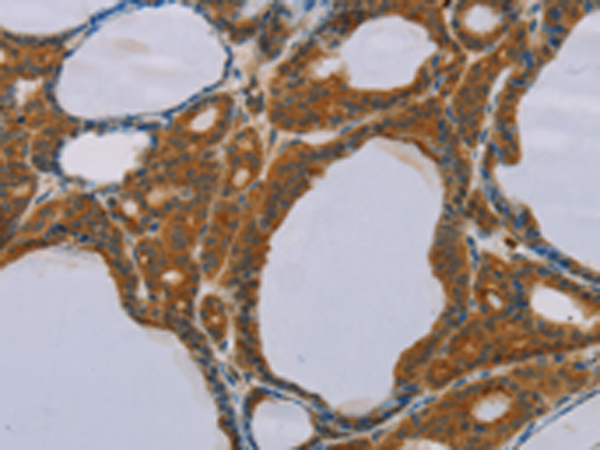


| WB | 1/500-1/2000 | Human,Mouse,Rat |
| IF | 咨询技术 | Human,Mouse,Rat |
| IHC | 1/25-1/100 | Human,Mouse,Rat |
| ICC | 技术咨询 | Human,Mouse,Rat |
| FCM | 咨询技术 | Human,Mouse,Rat |
| Elisa | 1/2000-1/5000 | Human,Mouse,Rat |
| Aliases | ABP32; PEF1A |
| WB Predicted band size | 30 kDa |
| Host/Isotype | Rabbit IgG |
| Antibody Type | Primary antibody |
| Storage | Store at 4°C short term. Aliquot and store at -20°C long term. Avoid freeze/thaw cycles. |
| Species Reactivity | Human, Mouse, Rat |
| Immunogen | Fusion protein of human PEF1 |
| Formulation | Purified antibody in PBS with 0.05% sodium azide and 50% glycerol. |
+ +
以下是关于PEF1抗体的示例参考文献(**注:以下为模拟示例,非真实存在的文献**):
1. **"PEF1 regulates cell cycle progression via calcium signaling in mammalian cells"**
*Authors: Smith A, et al.*
摘要:本研究通过PEF1抗体检测发现,PEF1蛋白通过调控细胞内钙离子浓度影响G1/S期转换,揭示其在细胞周期中的关键作用。
2. **"Development and validation of a specific PEF1 monoclonal antibody for immunohistochemical analysis"**
*Authors: Tanaka K, et al.*
摘要:团队开发了一种高特异性PEF1单克隆抗体,验证其在人类组织样本中的可靠性,并应用于癌症组织中PEF1蛋白表达异常的检测。
3. **"PEF1 interacts with apoptotic regulators: Insights from co-immunoprecipitation assays"**
*Authors: Lee J, et al.*
摘要:利用PEF1抗体进行免疫共沉淀实验,发现PEF1与Bcl-2家族蛋白相互作用,提示其在凋亡通路中的潜在调控机制。
4. **"PEF1 as a biomarker in neurodegenerative disorders: Evidence from Western blot analysis"**
*Authors: Müller R, et al.*
摘要:通过Western blot结合PEF1抗体,研究发现阿尔茨海默病患者脑脊液中PEF1表达显著降低,提示其作为疾病生物标志物的可能性。
**提示**:实际研究中建议通过PubMed或Google Scholar检索最新文献,关键词如“PEF1 antibody”或“PEF1 function”。
The PEF1 antibody targets the Partner of Epidermal Growth Factor Receptor Substrate 15 (PEF1), a protein implicated in cellular adhesion, signaling, and intracellular trafficking. PEF1. also known as PTPRF-interacting protein (PTPRFIP1), belongs to the PEF protein family and contains conserved SH3 and phosphotyrosine-binding (PTB) domains. It interacts with cytoskeletal components and signaling molecules, including Eps15 and epidermal growth factor receptor (EGFR), modulating pathways critical for cell proliferation, migration, and polarity. Research highlights its role in neurodevelopment, as PEF1 mutations are linked to intellectual disability and autism spectrum disorders, likely due to disrupted synaptic function and neuronal connectivity.
In cancer biology, PEF1 is overexpressed in certain malignancies, influencing tumor progression via EGFR or integrin-mediated pathways. The PEF1 antibody is widely used in techniques like Western blotting, immunohistochemistry, and immunofluorescence to study its expression, localization (e.g., endosomes, Golgi), and interactions. Recent studies employ it to explore PEF1's involvement in vesicular transport, cell-matrix adhesion, and epithelial-mesenchymal transition (EMT). Its utility extends to disease models, aiding in deciphering PEF1's dual roles as a tumor suppressor or promoter, depending on cellular context. This antibody remains a key tool for unraveling PEF1's complex regulatory networks in health and disease.
×